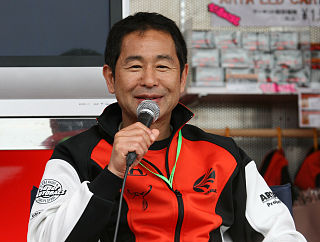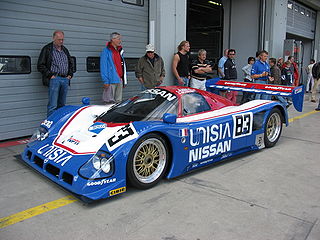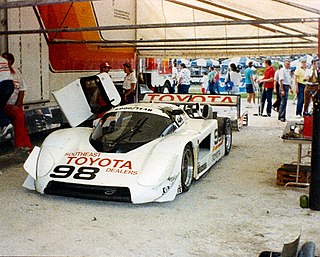
Nissan Motorsports International, abbreviated as Nismo, is a division of Nissan Motorsports & Customizing focused in motorsport and performance-oriented car models for Nissan. Nismo was initially a company, Nissan Motorsports International Co., Ltd., formed in 1984 as a result of a merger of two motorsport departments, being the in-house tuning, motorsports and performance subsidiary of Nissan. It has competed in JSPC, JTCC, the 24 Hours of Le Mans and the 24 Hours of Daytona. They currently participate in Super GT and Formula E. Nismo ceased to be a company in April 2022 by being merged with sister company Autech into a new Nissan subsidiary, Nissan Motorsport & Customizing.

Keiichi Tsuchiya is a Japanese professional race car driver. He is known as the Drift King for his nontraditional use of drifting in non-drifting racing events and his role in popularizing drifting as a motorsport. In professional racing, he is a two-time 24 Hours of Le Mans class winner and the 2001 All Japan GT Championship runner-up. He is also known for touge driving.

The Mitsubishi Starion is a two-door, turbocharged four-cylinder rear-wheel drive four-seat hatchback sports car manufactured and marketed by Mitsubishi from 1982 until 1989 — with badge engineered variants marketed in North America as the Conquest, under the Chrysler, Dodge, and Plymouth brands.

The Mazda 787 and its derivative 787B are Group C sports prototype racing cars that were developed by Japanese automobile manufacturer Mazda for use in the World Sportscar Championship, All Japan Sports Prototype Championship, and the 24 Hours of Le Mans from 1990 to 1991. Designed to combine a mixture of the Fédération Internationale du Sport Automobile (FISA) Group C regulations with the International Motor Sports Association (IMSA) GTP regulations, the 787s were the last Wankel rotary-powered racing cars to compete in the World and Japanese championships, using Mazda's R26B engine.

Group C was a category of sports car racing introduced by the FIA in 1982 and continuing until 1993, with Group A for touring cars and Group B for GTs.

The Jaguar XJR-9 is a sports-prototype race car built by Jaguar for both FIA Group C and IMSA Camel GTP racing, debuting at the 1988 24 Hours of Daytona.

The Toyota TS010 was a Group C racing car built by Toyota for the Sportscar World Championship, All Japan Sports Prototype Championship, and the 24 Hours of Le Mans.

The Nissan R390 GT1 was a racing car built in Atsugi, Japan. It was designed primarily to gain a suitable racing entry in the 24 Hours of Le Mans in 1997 and 1998. It was built to race under the grand touring style rules, requiring a homologated road version to be built. Therefore, the R390 was built originally as road car, then a racing version of the car was developed afterwards. Only one R390 road car was ever built and is stored at Nissan's Zama facility, although one of the race cars was later modified for road use. The road car was claimed to be capable of attaining a top speed of 354 km/h (220 mph). However, this claim has never been proven.

The Peugeot 905 is a sports-prototype racing car built by Peugeot's racing department, Peugeot Talbot Sport.

The McLaren F1 GTR is the racing variant of the McLaren F1 sports car first produced in 1995 for grand touring style racing, such as the BPR Global GT Series, FIA GT Championship, JGTC, and British GT Championship. It was powered by the naturally aspirated BMW S70/2 V12 engine. It is most famous for its overall victory at the 1995 24 Hours of Le Mans where it won against faster purpose-built prototypes in very wet conditions. The F1 GTR raced internationally until 2005 when the final race chassis was retired.

The Aston Martin AMR1 was a Group C formula racing car developed in 1989 for car manufacturer Aston Martin. It participated in the 1989 World Sports Prototype Championship and 1989 24 Hours of Le Mans.

The Nissan GT-R is a 2+2 seater, front mid-engine, all-wheel drive sports car and grand tourer, developed and produced by Nissan. It succeeds the Nissan Skyline GT-R, a high-performance variant of the Nissan Skyline luxury coupe. Although this model was the sixth-generation to bear the GT-R name, it is no longer part of the Skyline line-up. The GT-R is built on the PM platform, derived from the FM platform used in the Skyline and the Nissan Z models. Production is conducted in a shared production line at Nissan's Tochigi plant in Japan.
Advanced Engine Research, Ltd. is an auto racing engine manufacturer based in Basildon, Essex, England. Established in 1997, AER has developed winning engines for a number of high-profile international race series in sports car, prototype racing, rallying, touring car, and open wheel racing. They have designed engines derived from road car platforms, but their emphasis is on clean sheet designed engines with a focus on electronics and turbochargers. Their engines have raced in the 24 Hours of Le Mans, the World Endurance Championship (WEC), the European Le Mans Series (ELMS), the United SportsCar Championship (TUSC), GP3, British Touring Car Championship (BTCC), Nissan/Renault World Series, Grand-Am, Paris Dakar and FIA Sportscar Championship. They have worked with a number of manufacturers including Mazda, Ford, Hyundai, MG/Rover, Nissan, and Toyota. In 2012, AER developed and built Formula One turbo test engines to current rules and in July 2012, AER was chosen as engine partner and supplier to the new GP3 racing series. They currently supply engines for the Indy Lights series.

The Nissan R90C was a platform used for Group C racing cars built in 1990 by Nissan Motors for competition in World Sportscar Championship (WSC) based in Europe and the All Japan Sports Prototype Championship (JSPC). The cars based on the basic R90C platform would compete until 1993 before Nissan chose to withdraw from sports car racing, not returning until 1997. It won three JSPC championships and several significant endurance races during its career.

The Toyota 7 was a series of racing cars developed by Toyota Motor Company in cooperation with Yamaha Motor Corporation. Designed primarily for use in FIA Group 7 competition, it was Toyota's first purpose-built racing car project.

The Toyota 88C was a racing car entered by Toyota from 1988 to 1989. It is the successor to the Toyota 87C and the predecessor to the Toyota 88C-V. Like other Toyota-powered sports prototypes of the era, it was designed and built by Dome. The 88C is an evolution of the 87C, both models sharing the same chassis number designation. The 88Cs competed in the All Japan Sports Prototype Championship, the World Sports-Prototype Championship, and the North American Camel GT Championship.
The Allard J2X-C, or the Allard J2X as it is sometimes referred to, was a Group C sports racing car built by Allard in 1992 for use in international sports car racing events. It featured a 3.5-litre Cosworth DFR V8 engine, capable of producing around 580 hp. The J2X-C had bodywork that is more reminiscent of modern Le Mans Prototypes than a conventional Group C car, but the engine proved too weak for the level of downforce, and this, coupled with the fact that Allard Holdings were liquidated during the car's development, severely restricted the J2X and prevented it ever reaching its potential. One car was built.

The March 86G was a Group C and IMSA GTP sports racing car built by March Engineering. Built as simply a chassis with no engine, it was branded as one of three cars, the BMW GTP, the Buick Hawk or the Nissan R86V depending on which engine was placed in the chassis and which team was running it. There were a number of subtle bodywork changes to reflect the manufacturer which ran the car.

The Nissan Z, known in Japan as the Nissan Fairlady Z, is the seventh generation of the Z-car line of sports cars manufactured by Nissan. The model succeeded the 370Z, though is built on a modified and revised version of the previous generation's platform. The model also drops the numerical nomenclature of the previous generations.

The Toyota 87C, also known as the TOM'S 87C, was a Group C prototype sports car, designed, developed and built by Toyota, for use in sports car racing, specifcally the World Sportscar Championship, between 1987 and 1988.


















